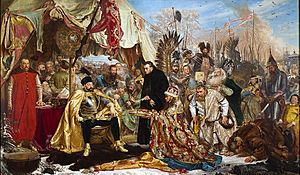Antonio Possevino facts for kids
Quick facts for kids
Antonio Possevino
|
|
|---|---|

Batory at Pskov. Painting by Jan Matejko. Possevino is the black-robed Jesuit at the center, blessing the offerings
|
|
| Born |
Antonius Possevinus
10 July 1533 Mantua, Duchy of Mantua
|
| Died | 26 February 1611 (aged 77) |
| Nationality | Italian |
| Occupation | papal diplomat, Jesuit controversialist, encyclopedist and bibliographer |
|
Notable work
|
Bibliotheca selecta qua agitur de ratione studiorum (1593) Apparatus ad omnium gentium historiam (2 vols., 1597–1602) Apparatus sacer ad scriptores Veteris et Novi Testamenti (3 vols., 1603–06) |
Antonio Possevino (also known as Antonius Possevinus) was an important Jesuit priest, born on July 10, 1533, and who passed away on February 26, 1611. He played a key role in the Counter Reformation, which was the Catholic Church's response to the Protestant Reformation. Possevino worked as a diplomat for the Pope, a writer who debated religious ideas, and someone who created encyclopedias and lists of books.
He was the first Jesuit to visit many countries in Eastern Europe, including Muscovy (old Russia), Sweden, Denmark, and Poland. He traveled on special missions for Pope Gregory XIII between 1578 and 1586, helping to spread the Pope's plans and influence.
Contents
Antonio Possevino's Life and Work
Early Life and Education
Antonio Possevino's family came from Mantua, a city in Italy known for its art and learning during the Renaissance. His father was a goldsmith. Antonio was born in 1533.
He had an older brother, Giovanni Battista Possevino, who was also a scholar. In 1549, when Antonio was 17, he went to Rome to study with his brother. There, he met many important thinkers and artists of the time. He became known for his intelligence and writing skills.
Antonio later worked as a tutor for the sons of a powerful family, the Gonzagas, in Ferrara, another important Italian city. He studied history and how to train future leaders.
Joining the Jesuits and Work in France
In 1559, Antonio Possevino decided to join the Society of Jesus, also known as the Jesuits. This was a new and influential Catholic religious order.
In 1560, he traveled to Savoy (part of modern-day France and Italy) with the leader of the Jesuits, Diego Lainez. There, Possevino helped strengthen the Catholic Church and founded Jesuit schools in cities like Turin. He also debated with Protestant leaders, trying to bring people back to the Catholic faith.
He then moved to France, which was experiencing religious wars between Catholics and Protestants (called Huguenots). Possevino worked to unite Catholics in cities like Lyon. He wrote books defending Catholic beliefs and helped distribute Catholic books. He even spent time in jail, but was rescued by powerful supporters.
In 1565, he successfully defended the Jesuit order at an important meeting in Bayonne, France, attended by King Charles IX and the future King Henri IV. King Henri IV remained a friend of Possevino throughout his life.
Diplomat for the Pope
From 1572 to 1578, Possevino worked as a secretary for the Jesuit leader in Rome. Then, Pope Gregory XIII sent him on important diplomatic missions.
Missions to Northern and Eastern Europe
Possevino traveled to many countries, including Sweden, Poland, and Russia. His goal was to support the Catholic Church and help resolve conflicts.
- Sweden: He visited King John III of Sweden to try and influence the Livonian War, a major conflict in the Baltic region.
- Russia: He went to the Russian capital to meet Ivan the Terrible, the powerful Tsar. Possevino helped to arrange a peace treaty between Ivan the Terrible and Stefan Bathory, the King of Poland, in 1582. This treaty was called the Treaty of Jam Zapolski. Possevino wrote valuable accounts of his travels and experiences in Russia.
- Poland: He helped establish important Jesuit institutions, including Vilnius University and other schools and seminaries. These efforts helped strengthen the Catholic presence in Poland.
Possevino's diplomatic work was very important during this time, as he worked to promote Catholic influence across Europe.
Later Years and Writings
After his protector, King Bathory, died in 1586, Possevino's diplomatic career ended. He was sent to Padua, Italy.
Becoming an Encyclopedist
In Padua, Possevino began a major scholarly project: organizing a vast library of Catholic knowledge. This led to his famous work, Bibliotheca selecta (1593). This book was a guide to important Catholic writings and was reviewed by leading scholars.
He then worked on another huge reference book called Apparatus Sacer (1603-1606). This multi-volume work provided an overview of different interpretations of the Old and New Testament by thousands of religious writers.
Possevino also continued to do pastoral work, helping people in his home city of Mantua. He even reconnected with King Henri IV of France, who had converted to Catholicism.
Final Years in Venice and Ferrara
In his later years, Possevino lived in Venice and Ferrara. He continued to write and debate religious issues. He was involved in conflicts between the Catholic Church and the Republic of Venice. Because of these disputes, he was eventually banished from Venice with other Jesuits.
Antonio Possevino died in 1611, leaving behind a legacy as a dedicated Jesuit, a skilled diplomat, and a prolific writer who greatly influenced the Counter Reformation.
Selected Works
- Apparatus sacer: A huge reference work about interpretations of the Old and New Testaments by many religious authors.
- Bibliotheca selecta: A guide to important Catholic writings and learning.
- Del sacrificio dell'altare (Lyons, 1563): A book about the Catholic Mass.
- Il soldato cristiano (Rome, 1569): A book for Christian soldiers.
- Muscovia (Vilna, 1586): His valuable account of his travels in Russia.
- Apparatus ad omnium gentium historiam (Venice, 1597): A work on the history of all nations.
In literature
Possevino appears in the early chapters of Alison Macleod's historical novel "Prisoner of the Queen." In the book, he is shown as a beloved and admired mentor to the main character.
Images for kids


